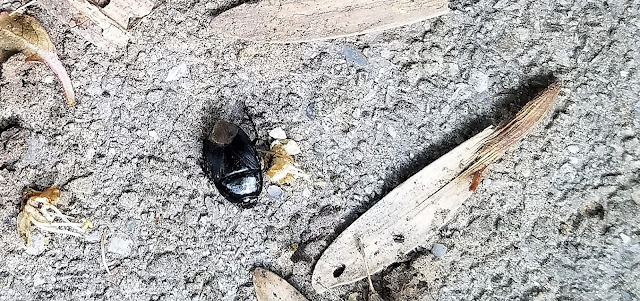'My Mary' Azalea
Introduced by George Beasley of Georgia, and named after his wife.
Eventually grows about 6' tall,
which it has accomplished in its large container on the patio.
All parts are poisonous if you have a desire to munch a bit.
It has problems with Lace Bugs if not kept moist enough to prevent stress.
Spent Azalea flower sliding down the pistil and stamens to fall to the ground.
Maybe a type of Crustose Lichens
Byzantine Gladiolus, Year 1629
Looks a bit different from indoors to outdoors.
It makes a terrible cut plant.
Flower colors are much prettier outdoors with lots of sun.
Early Afternoon — April 27
It’s a welcomed event of sorts, just relaxing on the
back deck in the new swivel rocker chairs, although I’m so dainty I can barely budge
mine into even a hint of a tilt. I watch,
a little perturbed, as Vic rocks away with the greatest of ease. Even though it’s light jacket weather, the
change from inside television to outside bird song is refreshing.
I was taken by surprise earlier this day when Vic
actually produced a pair of binoculars and intensely began viewing the Grey Owl
Juniper through the living room window from the couch. He declared with alarm that a squirrel was tearing
a bird’s nest apart. I was a little skeptical, but we were
instantly on a mission to save a bird’s nest that was not savable if it indeed
was being ripped to shreds.
After trampling the garden a bit, we could see
nothing but a big junction of branches with no nest in site. Back in the house, I notice the horror of all
horrors!!! A tick merrily making its way
up my shirt front in search of an easy meal.
He was flushed down that vortex of unholy water to kingdom come, but you
know how it is with these happenings… one feels pin pricks on their skin for
the rest of the day causing multiple checks in the mirror until bedtime.
Vic continued watching the junction of branches with
his binoculars, saying something was still out there. I watched next, and a blur flew into the
opening and two large baby bird heads stretched up over the branch with mouths
wide open for worms. I immediately
thought of the robin the day before. It
was confirmed as a robin after it flew in and out a few times. That was our unexpected excitement for the
day.
Back at the present time, our discussion on the back
deck turns to identifying the fragrance of ‘My Mary’ Azalea, mostly because I’m
the one keeping any kind of conversation going while we eat quiche bought from
a little French restaurant earlier in the day.
After testing the smell a few times, we agree it’s mostly vanilla with a
hint of cloves. Conversation is light…mostly
about childhood memories, until the chilly breezes of late afternoon chase us
inside.
Carex grayi, Grey Sedge
Long spike is the staminate (male)
Mace ball type spike below is the pistillate (female)
This native plant is quite aggressive in my gardens with all the rains.
North America Wild Hyacinth
White Clover, Trifolium repens
*
I feel, after much hardship,
that eradicating a weed from my garden isn't practical.
Managing the weed the year before is more practical,
although in the rush of the greening of spring,
they all break back out of jail :(
*
I have actually used a herbicide on this little beauty in the gardens,
as it's impossible to pull up all the roots.
Common Ninebark, Physocarpus opulifolius
*
I've limbed mine up a bit to remove aggressive weeds underneath,
so it is vase shaped instead of ball shaped.
The bark has become shaggy over the years,
giving it appeal when not blooming.
It's in full bloom now,
but the promise of ticks prevents me from exploring it further.
Lyreleaf Sage, Salvia lyrata
Flowers and seeds below that have formed
*
Some consider this an aggressive native,
but it has never become a problem.
I move new plants that pop up to areas where I need them.
It lives in sun, shade, wet, dry … what's not to love.
Allegheny Spurge, Pachysandra procumbens
growing around 'Tokudama' Hosta which is now considered a cultivar.
The Hosta was originally discovered in 1860 in Nagasaki, Japan
in the garden of Von Siebold.
It has never been found as a colony in the wild.
Monarda bradburiana, Beebalm-Eastern, Bergamot
One lousy out-of-focus bug … what gives?
Clematis 'Arabella'
All Day — April 28
Nothing, except to write this post, work on the photos, and chill out. I finally spent time in my studio and finished setting up my laptop. Still working on adding Norton, Microsoft Office, and Adobe Photoshop. Don't hold your breath! I seem to have only one speed that never gets out of first gear.
Take care, and goodnight or good morning or good day or good grief or …
Finally! — April 29
Publishing...then out to the gardens to mingle among the ticks and weeds.
This Post is Linked to:



.jpg)
.jpg)

.jpg)


.jpg)


.jpg)

.jpg)




.jpg)



.jpg)
.jpg)
.jpg)
.jpg)
.jpg)



.jpg)
.jpg)
.jpg)


.jpg)

.jpg)

.jpg)
.jpg)

.jpg)
%20-%20Copy.jpg)
.jpg)


.jpg)
.jpg)
.jpg)


.jpg)
.jpg)

.jpg)
.jpg)
.jpg)




.jpg)



